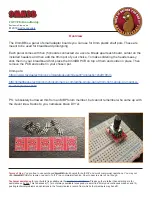
Functional Safety Manual
for the Memosens transmitter Liquiline M CM42 SIL
Version:
Page:
2.0
13
of
72
A
ll
e
R
ec
h
te
v
o
rb
eh
al
te
n
.
D
as
K
o
p
ie
re
n
d
ie
se
s
D
o
k
u
m
en
ts
u
n
d
d
ie
V
er
w
en
d
u
n
g
v
o
n
T
ei
le
n
au
s
d
ie
se
m
D
o
k
u
m
en
t
is
t
o
h
n
e
sc
h
ri
ft
li
ch
e
G
en
eh
m
ig
u
n
g
d
er
E
n
d
re
ss
+
H
au
se
r
C
o
n
d
u
ct
a
G
m
b
H
+
C
o
.
K
G
n
ic
h
t
er
la
u
b
t.
A
ll
ri
gh
ts
re
se
rv
ed
.
P
as
si
n
g
o
n
an
d
co
p
yi
n
g
o
f
th
is
d
o
cu
m
en
t,
u
se
an
d
co
m
m
u
n
ic
at
io
n
o
f
it
s
co
n
te
n
ts
n
o
t
p
er
m
it
te
d
w
it
h
o
u
t
w
ri
tt
en
au
th
o
ri
za
ti
o
n
fr
o
m
E
n
d
re
ss
+
H
au
se
r
C
o
n
d
u
ct
a
G
m
b
H
+
C
o
.
K
G
.
2.1.2
Safety Function 2 (SAF2) – safe measurement
The safety function of the measuring chain is the output of the pH value on the current
output. To that end the mV and T value is received from the sensor with a given
precision and resolution, the pH value is computed and finally converted to a mA value,
which is then put out to the current output.
All errors (rounding, computations, conversion from pH to mA, etc.) caused by the
Liquiline M CM42 transmitter can be completely neglected compared to the errors on
the current output and the sensor.
The mV value from the Orbisint CPS11D sensor (communicated by the Memosens
protocol to the transmitter) has a resolution of
±
0.1mV, the temperature
±
0.01K, the
pH value
±
0.01pH, the slope
±
0.001pH/mV and the zero point
±
0.001pH. The
precision of all values is given in the safety manual of the sensor.
2.1.3
Precision and Timing of SAF1 and SAF2
For all information or results given here, we assume we have no errors in the slope and
zero point of the sensor.
The error of the Liquiline M CM42 transmitter on the current output caused by the
hardware is
below
±
0.05 mA
for the complete range from 4-20 mA and for all possible
allowed EMC/environment conditions. See the table in chapter 2.2 for the dependency
of current output spread and the precision.
If we assume that the slope, the zero point and temperature offset (=all sensor
adjustment values) have no errors, we get:
Error limit for zero point is ±0.001 pH (= resolution of storage in sensor),
Error limit for the slope at 25°C/77°F is ±0.001 pH/mV
(= resolution of storage in sensor),
Error limit for voltage value U from sensor is denoted as DU
(= resolution storage is ±0.1 mV),
Error limit for temperature value T from sensor is denoted as DT
(= resolution storage is ±0.01 K).
All errors due to the finite resolution of the values can always be neglected; they are
well below the measurement errors. Additionally, as stated already, all rounding errors
of the software can be neglected too; they are far below the measurement errors.
So the relative error limit of the calculated pH value D
pH
is just given by the temperature
measurement and the voltage measurement relative errors of the sensor:
D
pH
/ pH = DU / U + DT / T.














































